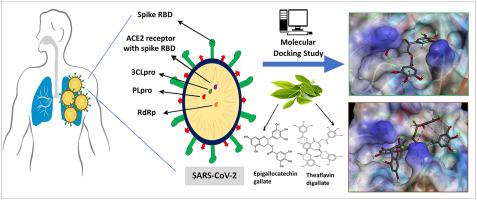Computers in Biology and Medicine ( IF 7.0 ) Pub Date : 2020-11-23 , DOI: 10.1016/j.compbiomed.2020.104137 Susmit Mhatre 1 , Shivraj Naik 1 , Vandana Patravale 1

|
Background
COVID-19 is an infectious disease caused by a novel positive-sense single-stranded RNA coronavirus called as SARS-CoV-2. This viral disease is known to infect the respiratory system, eventually leading to pneumonia. Crystallographic studies of the viral structure reveal its mechanism of infection as well as active binding sites and the druggable targets as scope for treatment of COVID-19.
Hypothesis
The role of tea polyphenols in prophylaxis and treatment of COVID-19 was established in this study.
Study design
Molecular docking interactions of tea polyphenols with some of the possible binding sites of SARS-CoV-2 were performed.
Materials and methods
From various studies on the SARS-CoV-2 reported in the literature, we chose possible drug targets (Chymotrypsin-like protease, RNA dependant RNA polymerase, Papain like protease, Spike RBD and ACE2 receptor with spike RBD) which are vital proteins. These receptors were docked against two tea polyphenols, Epigallocatechin gallate (EGCG) from green tea and Theaflavin digallate (TF3) from black tea. These polyphenols have been previously reviewed for their antiviral activities, especially against single-stranded RNA viruses. Two antiviral drugs, Remdesivir and Favipiravir were studied for comparative docking results.
Results
A comparative study of docking scores and the type of interactions of EGCG, TF3 with the possible targets of COVID-19 showed that the tea polyphenols had good docking scores with significant in-silico activity.
Conclusion
These results can provide a lead in exploring both the tea polyphenols in prophylaxis as well as treatment of COVID-19.
中文翻译:

EGCG 和茶黄素二没食子酸酯与 SARS-CoV-2 药物靶点的分子对接研究
背景
COVID-19 是一种由新型正链单链 RNA 冠状病毒(称为 SARS-CoV-2)引起的传染病。已知这种病毒性疾病会感染呼吸系统,最终导致肺炎。病毒结构的晶体学研究揭示了其感染机制以及活性结合位点和可药物靶标作为 COVID-19 的治疗范围。
假设
本研究确立了茶多酚在预防和治疗 COVID-19 中的作用。
研究设计
进行了茶多酚与 SARS-CoV-2 一些可能的结合位点的分子对接相互作用。
材料和方法
从文献报道的 SARS-CoV-2 的各种研究中,我们选择了可能的药物靶点(胰凝乳蛋白酶样蛋白酶、RNA 依赖性 RNA 聚合酶、木瓜蛋白酶样蛋白酶、刺突 RBD 和刺突 RBD 的 ACE2 受体),这些都是重要的蛋白质。这些受体与两种茶多酚对接,即绿茶中的表没食子儿茶素没食子酸酯 (EGCG) 和红茶中的茶黄素二没食子酸酯 (TF3)。这些多酚的抗病毒活性,特别是针对单链 RNA 病毒的活性,之前已被审查过。研究了两种抗病毒药物瑞德西韦和法匹拉韦,以比较对接结果。
结果
对对接分数以及 EGCG、TF3 与 COVID-19 可能目标的相互作用类型的比较研究表明,茶多酚具有良好的对接分数和显着的计算机活性。
结论
这些结果可以为探索茶多酚在预防和治疗 COVID-19 中的作用提供指导。











































 京公网安备 11010802027423号
京公网安备 11010802027423号